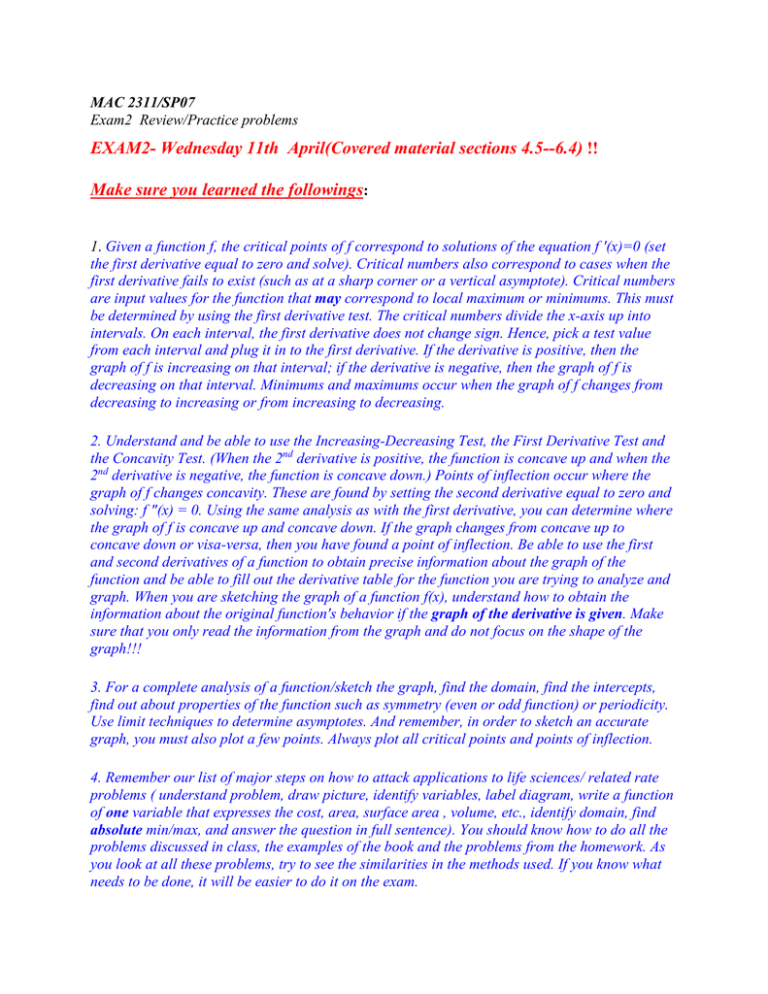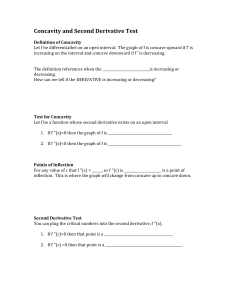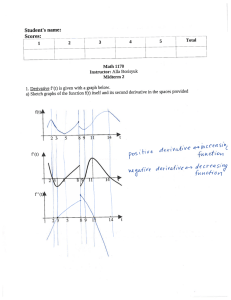Practice problems/Review for Exam 2
advertisement

MAC 2311/SP07 Exam2 Review/Practice problems EXAM2- Wednesday 11th April(Covered material sections 4.5--6.4) !! Make sure you learned the followings: 1. Given a function f, the critical points of f correspond to solutions of the equation f '(x)=0 (set the first derivative equal to zero and solve). Critical numbers also correspond to cases when the first derivative fails to exist (such as at a sharp corner or a vertical asymptote). Critical numbers are input values for the function that may correspond to local maximum or minimums. This must be determined by using the first derivative test. The critical numbers divide the x-axis up into intervals. On each interval, the first derivative does not change sign. Hence, pick a test value from each interval and plug it in to the first derivative. If the derivative is positive, then the graph of f is increasing on that interval; if the derivative is negative, then the graph of f is decreasing on that interval. Minimums and maximums occur when the graph of f changes from decreasing to increasing or from increasing to decreasing. 2. Understand and be able to use the Increasing-Decreasing Test, the First Derivative Test and the Concavity Test. (When the 2nd derivative is positive, the function is concave up and when the 2nd derivative is negative, the function is concave down.) Points of inflection occur where the graph of f changes concavity. These are found by setting the second derivative equal to zero and solving: f "(x) = 0. Using the same analysis as with the first derivative, you can determine where the graph of f is concave up and concave down. If the graph changes from concave up to concave down or visa-versa, then you have found a point of inflection. Be able to use the first and second derivatives of a function to obtain precise information about the graph of the function and be able to fill out the derivative table for the function you are trying to analyze and graph. When you are sketching the graph of a function f(x), understand how to obtain the information about the original function's behavior if the graph of the derivative is given. Make sure that you only read the information from the graph and do not focus on the shape of the graph!!! 3. For a complete analysis of a function/sketch the graph, find the domain, find the intercepts, find out about properties of the function such as symmetry (even or odd function) or periodicity. Use limit techniques to determine asymptotes. And remember, in order to sketch an accurate graph, you must also plot a few points. Always plot all critical points and points of inflection. 4. Remember our list of major steps on how to attack applications to life sciences/ related rate problems ( understand problem, draw picture, identify variables, label diagram, write a function of one variable that expresses the cost, area, surface area , volume, etc., identify domain, find absolute min/max, and answer the question in full sentence). You should know how to do all the problems discussed in class, the examples of the book and the problems from the homework. As you look at all these problems, try to see the similarities in the methods used. If you know what needs to be done, it will be easier to do it on the exam. MAC 1147 EXAM 1 - M. RAHMAN Suggested practice problems(you should practice more exercises from the book): Section 4.5 -# 4, 6, 8, 12, 16, 18, 22, 24, 34, 39 Section 4.6 # 4, 6, 8, 10, 12, 14, 16, 18, 22, 26 Section 5.1 # 6, 10, 12, 16, 20, 22, 25, 37, 39 Section 5.2 # 6, 10, 12, 21, 26 Section 5.3 # 4, 6, 8, 16, 20, 22, 24, 25, 30, 34, 40 Section 5.4 # 13, 14, 20 Section 6.1 # 4, 10, 14, 16, 22, 24, 25 Section 6.2 # 6, 24, 30 Section 6.3 # 4, 6, 14, 16, 20, 22, 28 Section 6.4 # 6, 8, 14, 18, 19 Applications to life sciences/others: PAGE 249: EX. 50 (Learning) PAGE 276: EX. 40, 41(Drug concentration) PAGE 289: EX38 (Milk consumption) PAGE 303: EX. 61, 66(Drug concentration) PAGE 315: EX. 44 (Neuron communication) PAGE 330: EX. 46 (Gasoline Mileage) PAGE 332-342: EXAMPLE #1, 3, 4, Exercise 6(Pollution), 24, 30, 38 PAGE 349-356: Example 1, 2, 3, Exercise 18(Learning skill), 22, 30 Read all sections, do hw & quizzes, and read class note!!! F2006 Copyright 2006 University of North Florida Page 2


